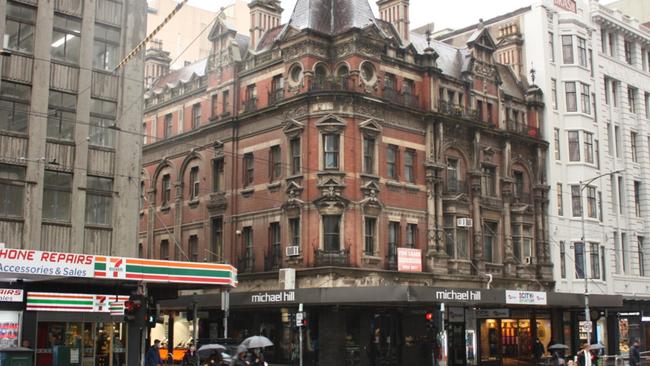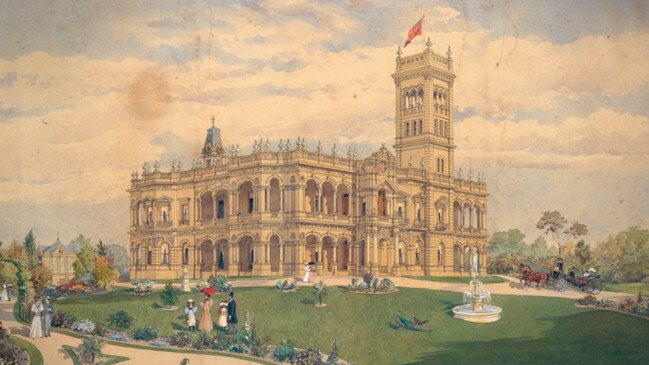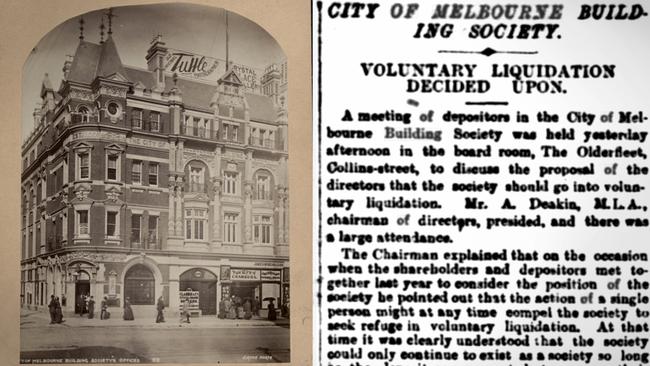How elite Melbourne society went from boom to bust
A grimy building on Elizabeth St was once home to an elite society set up to sculpt the face of Melbourne – until scandal brought it undone.

Victoria
Don't miss out on the headlines from Victoria. Followed categories will be added to My News.
There is little doubt the grimy and eccentric City of Melbourne Building on Elizabeth St is one of the city’s most intriguing structures.
The grand old dame, built in the style of the Queen Anne period with jutting slate roofs and eclectic, mismatched windows, has watched silently over the intersection of Little Collins Streets for 134 years.
Its haunted-house-style design and dirty facade have led plenty of Melburnians to think it needs a good once-over with a high-pressure hose.
Some have simply passed and wondered – what’s with that old-fashioned place on the corner that looks more suited to Nineteenth Century London than modern Melbourne?
But we should count ourselves lucky that the enchanting heritage-listed building is there at all.
The extraordinary boom-and-bust story of the elite Melbourne society that built it as a base to sculpt the face of Melbourne, only to spectacularly collapse amid fraud charges, is often forgotten.

Paved with gold
There was a time when Melbourne was so rich, the cash seemed to drip from every window.
Following the rapid expansion of the gold rush, the land boom of the 1880s made speculators wealthy beyond imagination.
During this period of extraordinary economic growth it was estimated that Melbourne was the wealthiest city in the world.
One of the key operators in the bullish world of Melbourne property was Matthew Davies.
An Englishman by birth and a lawyer by trade, Davies was mayor of Prahran, a member of the Legislative Assembly and grew a business empire of more than three dozen companies, all dealing with Melbourne land and building.
For Matthew Davies, it seemed the boom times would never end.

His personal wealth ballooned and in 1882 he built a sprawling mansion in Lansell Rd, Toorak, called Bracknell.
Five years later, even richer, he had the huge home renovated and expanded.
As Melbourne rocketed towards its apparent destiny as the wealthiest place on the planet, Davies founded the City of Melbourne Building Society, a land finance group that attracted a large number of the city’s business elite, including future prime minister Alfred Deakin.
In 1888 architects Ellerker and Kilburn were contracted to draft the exquisite facade of the society’s headquarters – a bold new look with tall, pitched roofs, delicate and poky balconies, intriguing windows of all shapes and ornate, sculpted parapets.
This building was, in a nutshell, everything the forward-looking building society thought of themselves.
Grand, bordering on brash, dripping with money and not afraid to use it.
For a few years, things went well.
But the bubble was about to burst.

The big bust
In early 1891 the land boom came to an abrupt end.
Factors included a sharp fall in the price of wool and an evaporation of overseas investment.
The City of Melbourne Building Society was heavily exposed to the sharp drop-off in land value, and Matthew Davies’ own companies went to ruin.
Davies resigned from the Victorian parliament and made a desperate voyage to London to find finance for his ailing business empire.
But he was unsuccessful.
With his dozens of companies starting to default on payments, Davies returned to Melbourne and faced the humiliation of insolvency.
By September 1892 the City of Melbourne Building Society faced oblivion.
At a special meeting chaired by Alfred Deakin himself, the board members agreed to enter voluntary liquidation.
By January 1893 Davies faced fraud charges over the alleged fabrication of balance sheets, but after a lengthy adjournment the charges were dropped.
He sailed again for England but was arrested half way; a new Attorney General had brought the same charges back.
He faced court and was eventually acquitted.
But the good times didn’t come again for Davies.

The losses across all his companies totalled a jaw-dropping four million pounds, believed to be one of the largest such losses in the history of the country.
His own personal debt had climbed to 280,000 pounds, rendering him bankrupt in 1894.
And it wasn’t just Davies who suffered in the crunch.
When the land bubble burst, Melbourne society from top to bottom was plunged into a depression lasting several years.
Banks failed and unemployment skyrocketed.
Once-wealthy speculators were left on the streets and slums appeared on Melbourne’s fringe.
Davies, a man who once dwelled in one of Melbourne’s largest mansions, resumed a humble life and weathered the depression by returning to his legal practice.
He died in 1912 at the age of 62.
The City of Melbourne Building, a monument to that brief sliver of time when Melbourne was the richest town on Earth, somehow survived and still stands in Elizabeth St where its current tenants include two jewellers and a sports apparel retailer.
More Coverage
Originally published as How elite Melbourne society went from boom to bust




